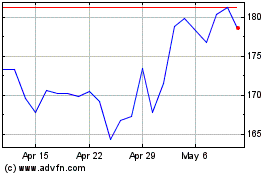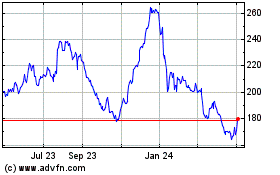Treasury Yields Are Supported by Borrowing Binge
May 01 2020 - 3:21PM
Dow Jones News
By Sam Goldfarb
U.S. government bond prices edged lower Friday even as stocks
fell sharply, following another record-setting month for U.S.
corporate bond sales.
In recent trading, the yield on the benchmark 10-year U.S.
Treasury note was 0.632%, according to Tradeweb, compared with
0.619% Thursday.
Yields, which rise when bond prices fall, climbed as the S&P
500 dropped around 3% -- a break from the typical pattern in which
stock declines fuel demand for safer assets and gains in
Treasurys.
One factor that analysts say has kept yields from dropping lower
this week has been the continued wave of new bonds entering the
market. Companies last month sold more than $227 billion of
investment-grade corporate bonds in the U.S. market, breaking the
previous record of $194 billion set a month earlier, according to
Dealogic.
The boom in issuance was capped Thursday when Boeing Co. sold
$25 billion of bonds, more than $16 billion of which carried
maturities of 10 years or more.
The corporate bond sales -- which have been fueled by businesses
trying to raise cash so they can weather disruptions caused by the
coronavirus pandemic -- have come as the Treasury Department has
also boosted debt auctions to fund a ballooning federal budget
deficit.
Though the bulk of its borrowing has come in the form of
short-term bills that mature in one year or less, the department
has also increased the size of its longer-term debt sales and is
expected to announce plans to issue more longer-term debt in its
quarterly refunding statement next week.
Increases in corporate and government bond sales can lift
Treasury yields, due to supply-demand dynamics, as fixed-income
investors have more options to choose from.
Pushing in the opposite direction, the Federal Reserve has been
buying large amounts of Treasurys -- and has promised to buy
corporate bonds -- as part of its efforts to help the economy and
improve liquidity in the market. The central bank, however, hasn't
been buying as many longer-term bonds as some had expected, and it
passed on an opportunity this week to announce a shift in its
strategy.
Not including inflation-protected securities, roughly 61% of the
Treasurys the Fed has bought since March have carried maturities of
five years or less, according to NatWest Markets. That compares
with just 14% for the same category of bonds in the last stage of
the Fed's previous bond-buying program -- known on Wall Street as
quantitative-easing or QE -- that followed the 2008 financial
crisis.
Heading into the Fed's policy meeting on Wednesday, there had
been some expectation that the central bank "would announce a more
normal plan and that that would look something more akin to past
QEs," said John Briggs, head of Americas strategy at NatWest. The
Fed's decision not to do that, coupled with the heavy supply of new
bonds, has been a drag on Treasurys, he added.
Write to Sam Goldfarb at sam.goldfarb@wsj.com
(END) Dow Jones Newswires
May 01, 2020 15:06 ET (19:06 GMT)
Copyright (c) 2020 Dow Jones & Company, Inc.
Boeing (NYSE:BA)
Historical Stock Chart
From Jun 2024 to Jul 2024

Boeing (NYSE:BA)
Historical Stock Chart
From Jul 2023 to Jul 2024
